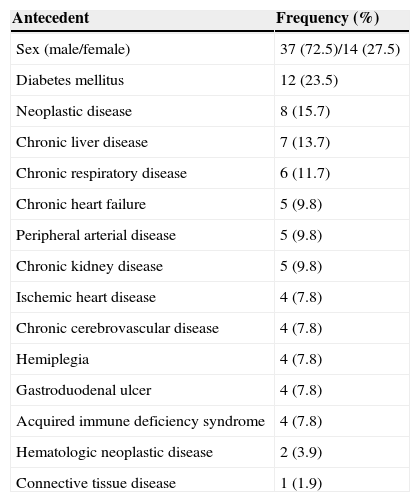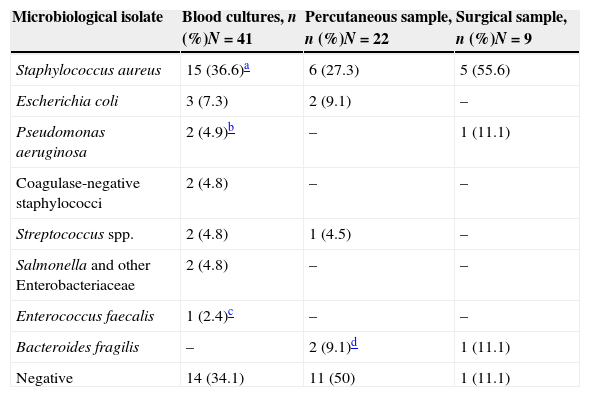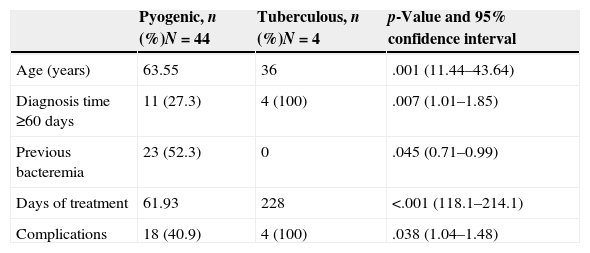Vertebral osteomyelitis (VO) is a rare entity, although its incidence has increased in recent years. The objective is to describe the patients with this infection in our environment and a comparison with other published series.
MethodsA retrospective review was conducted of epidemiological, clinical, microbiological, treatment, complications and evolution data of patients with VO during 10 years (2004–2014) in two hospitals of Mallorca.
Results51 cases, median age 66 (range 22–85) years, 37 (72.5%) men with a mean onset of symptoms of 80.1±125.1 days. In thirty-six (70.6%) cases the origin of infection was considered hematogenous, although previous bacteremia was documented in 23 (45%) cases, being of urinary in 10 (43.5%) cases. Clinically at the moment of diagnosis 35 (68.8%) had fever, 32 (62.7%) pain, 14 (27.5%) irradiated nerve pain and 10 (19.6%) paralysis/paresia. MRI was the most performed radiological test 46 (90.2%), being pathological in all cases. Staphylococcus aureus 23 (52.3%) was the most common microbiological isolates. At the moment of the diagnosis, blood cultures were positive in 27 (65.8%) of 41 cases and 11 (50%) of 22 percutaneous puncture was positive. Paraspinal, epidural or psoas abscesses were observed in 23 (45.1%), neurological deficit in 7 (13.7%) and chronic pain in 6 (11.8%). One patient (1.9%) died in relation with infection.
ConclusionsDiagnosis was delayed in most cases. Previous bacteremia being main predisposing factor and hematogenous origin the main source of infection. S. aureus was the most isolated. Percutaneous puncture together with blood cultures increase etiologic diagnosis. A high percentage of patients had complications or sequelae.
La espondilitis infecciosa (EI) es una entidad poco frecuente cuya incidencia ha aumentado en los últimos años. El objetivo de este estudio ha sido describir los casos con EI y realizar una comparación con el resto de series publicadas.
Material y métodosEstudio retrospectivo donde se describen datos epidemiológicos, microbiológicos y clínicos de los pacientes diagnosticados de EI durante un periodo de 10 años (2004-2014) en 2 hospitales de Mallorca.
ResultadosSe incluyó un total de 51 pacientes, con una edad mediana de 66 años (rango 22-85). El 72,5% (37/51) fueron varones. El tiempo medio transcurrido desde el inicio de la clínica hasta el diagnóstico fue de 80,1±125,1 días. En 36 ocasiones (70,6%) el origen fue hematógeno. El factor predisponente más frecuente fue presentar bacteriemia previa (10 [43,5%] de origen urinario). Presentaron fiebre 35 pacientes (68,8%), dolor 32 (62,7%), radiculalgia 14 (27,5%) y parálisis/paresia 10 (19,6%). La prueba diagnóstica más utilizada fue la resonancia magnética (46 [90,2%]), resultando patológica en todos los casos. El microorganismo etiológico más frecuente fue Staphylococcus aureus (23 [52,3%]). Los hemocultivos resultaron positivos en 27/41 ocasiones (65,8%) y la punción percutánea en 11/22 (50%). Veintitrés pacientes (45,1%) desarrollaron abscesos paravertebrales, epidurales o del psoas, 7 (13,7%) déficits neurológicos residuales y 6 (11,8%) dolor crónico. Un paciente (1,9%) falleció por motivos relacionados con la infección.
ConclusionesLa EI es poco frecuente. Su origen usualmente es hematógeno. La bacteriemia previa es el factor predisponente más importante. El diagnóstico es habitualmente tardío, siendo Staphylococcus aureus el germen implicado con mayor frecuencia. La realización de punciones percutáneas acompañando a los hemocultivos aumenta la rentabilidad diagnóstica.
Article
Diríjase desde aquí a la web de la >>>FESEMI<<< e inicie sesión mediante el formulario que se encuentra en la barra superior, pulsando sobre el candado.

Una vez autentificado, en la misma web de FESEMI, en el menú superior, elija la opción deseada.

>>>FESEMI<<<










